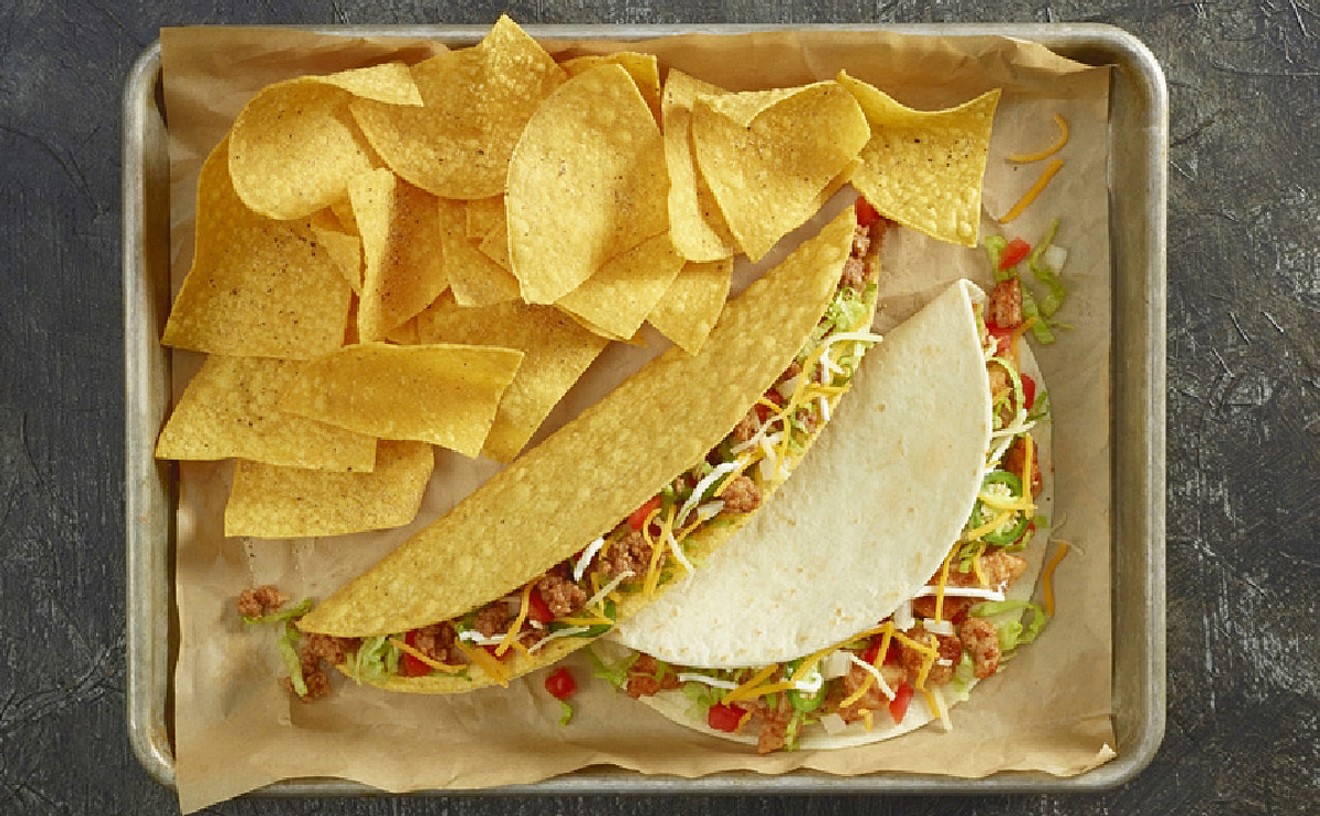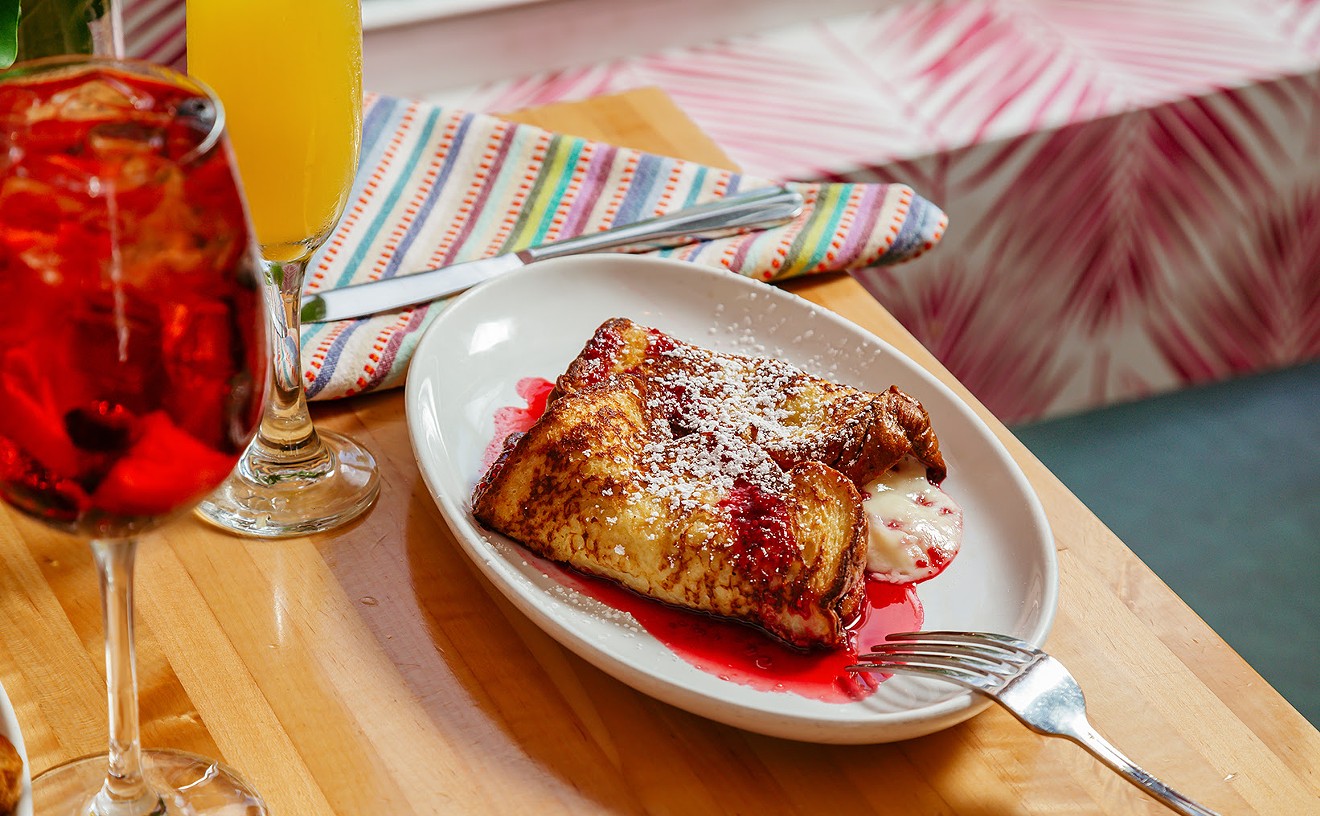Fans of Siam River, a traditional-looking Thai restaurant with a clutter of wood-carvings and Far Eastern imports, will be taken aback by Moon's clean, pastel-bright minimalist décor. It's an attractive and comfortable space, with not much to note other than long, roomy booths with lacquered blond wood tables, small colored lamps suspended from the ceiling, pussy willows and flower arrangements here and there, a full-service bar whose selection of sakes is disappointingly restricted to "hot" and "cold," and a sushi bar with far more choices than that. The difference in design between the two Thais reflects the neighborhoods they're in: Siam River on the 163rd Street causeway and Moon across the way from the University of Miami. Indeed much of the Moon crowd seems to be made up of students, though admittedly I'm basing that assumption mostly on overhearing young voices in the next booth discussing Sartre over their satay.
Waitresses smartly attired in Asian outfits provided exceptional service; they were particularly good at anticipating needs, whether that be small plates for a shared appetizer or the check when it was time to go. They also were well acquainted with the two laminated and voluminous menus -- one Thai (112 items), one Japanese (144 items), both filled with crisp descriptions and color photos of the food. As the owners and staff are Thai, we concentrated mostly on that country's cuisine, though we did try a pristine sushi sampler: grilled tofu steak covered in a sweet, syrupy, and properly potent teriyaki sauce; and a "dynamite shell" comprising minced snapper, conch, crabmeat, and salmon caviar bound by spicy mayo and browned in a pearly scallop shell.
Quintessential Thai cuisine is healthful, flavorful, colorful, and filled with a variety of tastes: sweet, sour, salty, bitter, hot. The Thais inherited this discipline of the five flavors from the Chinese, as well as their principal cooking technique of cutting food into small pieces before steaming or stir-frying -- a method that's long on prep, short on cooking time, and emphasizes freshness. We started with a few Bangkok-style street-vendor snacks, including the pleaser from Indonesia: six lean strips of beef that are first marinated in coconut milk, curry paste, cane sugar, and nam pla (fish sauce), then threaded on a skewer and sizzled quickly over the grill. You say "satay," I say "saté," and Moon says "satei," but it's the same thing, sided with peanut dipping sauce, a small bowl of vinegared cucumber salad, Boston lettuce leaves for wrapping around the meat, and huge plumes of mint, cilantro, and basil; the presentations here are simple yet striking. Steamed dumplings (khanom jeeb) were standard, plumped with ground pork, mushrooms, bamboo shoots, and scallions, but green papaya salad was sublime and noteworthy for containing most staples of the Thai kitchen: chilies, garlic, palm sugar, nam pla, cilantro, and lime, plus cherry tomatoes, roasted peanuts, a trio of juicy shrimp, and, of course, shredded green papaya. All these foods go great with beer, and Moon has about a dozen types from which to choose.
About the only common Thai ingredient omitted in the papaya salad was coconut milk, but you can savor that flavor in seven of eight curry selections, which are further compartmentalized into beef, chicken, shrimp, pork, and vegetable. We tried the vegetarian massaman (here spelled mussamun) -- most popular among the Muslims of southern Thailand -- which contained potatoes, cauliflower, broccoli, avocados, and cashews in a piquant (the waitress inquires beforehand as to what degree) coconut-based sauce aromatic with cloves, cardamom, and cinnamon -- spices not usually favored by the Thais. The white long-grain rice scooped onto our plates did its job of diluting the more fiery aspects of the food, which is partly why the average Thai will consume almost a pound of the grain per day. The rice also serves to extend the customarily small portions of meats and vegetables, a tactic evidently employed in their American restaurants as well.
Tom yum kai soup contained poached chicken breast and straw mushrooms in a chicken stock infused with lemon grass, kaffir lime leaves, and lime juice -- quite tart and also flecked with red pepper flakes. A more substantial duck noodle soup (considered a noodle dish, not a soup) can serve as a main course for one, or soup for two or three. Either way it's worth a try, as robust segments of roasted duck, thin flat rice noodles, and a sprinkling of bean sprouts are delectably sweet in a broth perfumed with cinnamon.
While the Thais have always taken advantage of an inherent bounty of fresh and saltwater fish, they neglected their scallop beds until Europeans and Americans demonstrated the comestibility of that mollusk. (Thais, incidentally, call scallops "hoy shell" after the scalloped Shell gas station signs punctuating their countryside.) Ginger scallops are prepared in sprightly fashion at Moon, as is ginger snapper, a fried whole fish topped with strips of that root, straw mushrooms, onions, scallions, and red peppers in a thin brown soybean sauce; this same fish also comes steamed or grilled. Squid and shrimp are available in varying combinations too, but if you want more exotic seafood, you'll have to switch over to the Japanese menu.
Credit the Portuguese for first bringing hot peppers to Thailand (though nowadays even Mexican serranos are grown there), and credit the kitchen crew at Moon for knowing how to use them judiciously, as demonstrated in the pad prik khing, stir-fried squares of tender pork with green beans and just the right kick of hot chili paste. There are plenty of other pork preparations to choose from, along with numerous variations on chicken, beef, and duck. Moon also offers grilled rack of lamb with honey plum sauce, a bona fide bargain at $14.95.
The quality continues unabated through dessert, which includes Thai doughnuts, cheesecake tempura, refreshing green-tea ice cream, and pumpkin custard, a savory acorn squash baked with a coconut milk filling that's only mildly sweetened with palm sugar. Served in quarters, it's a noncloying finale, if one most likely to be enjoyed by those who don't usually fancy dessert at all. I can't imagine anyone not being intoxicated by sticky rice with mango, a much anticipated denouement to the hot days of mango season in Thailand -- meaning apropos for right here in South Florida. When the short-grained, opaque, and highly glutinous rice is finished cooking, sweetened coconut milk gets poured over, the rice absorbing the liquid as it cools. Specks of toasted sesame seeds topped Moon's celestial take on this specialty, but the pièce de résistance was a perfectly ripe, sweet mango cut into bite-size pieces. We cleaned the plate quicker than you can say "best rice pudding in town." We finished up with a glass of Thai iced tea, made from robustly rust-colored tea leaves blended with half-and-half and sugar (not, as usually is the case, evaporated milk). We'll be back to Moon real soon.










